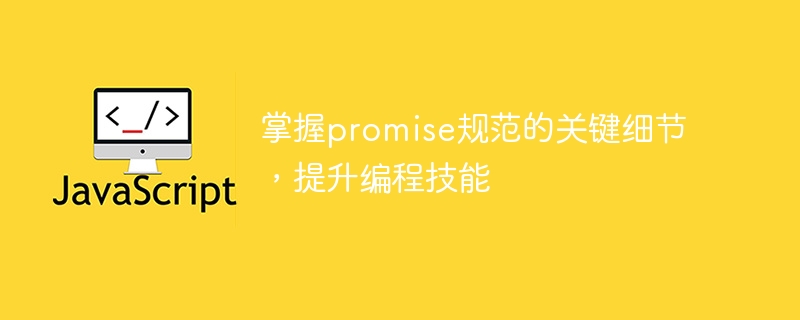

In modern JavaScript programming, asynchronous operations are very common. In the past, to handle asynchronous operations, we used callback functions to handle asynchronous results. However, the problem of nested callback functions soon gave rise to the concept of "callback hell". To solve this problem, JavaScript introduced the Promise specification.
Promise is a specification for handling asynchronous operations, which provides a more elegant way to handle asynchronous code and handle asynchronous results. Its core idea is to use chain calls to handle asynchronous operations.
To master the key details of the Promise specification, you first need to understand the basic characteristics of Promise. Promise has three states: pending (in progress), fulfilled (successful) and rejected (failed). When a Promise object is created, its initial state is pending. When the asynchronous operation completes successfully, the Promise enters the fulfilled state. When the asynchronous operation fails, the Promise enters the rejected state.
A Promise object can register two callback functions through the then method, one for processing the result of a successful asynchronous operation, and the other for processing the result of a failed asynchronous operation. These two callback functions are passed in as the two parameters of the then method. When the Promise is in the fulfilled state, the first callback function will be called and the result of the asynchronous operation will be passed in; when the Promise is in the rejected state, the second callback function will be called and the error message will be passed in.
In addition, Promise also has a catch method to catch possible errors. The catch method receives a callback function as a parameter. When the Promise is in the rejected state, the callback function will be called and error information will be passed in.
In addition to the above basic features, Promise also has some other important features, such as: chain calls of promises, parallel execution of multiple asynchronous operations, error handling, etc. To grasp these details, we need to understand the Promise specification in depth.
When using Promise, some common issues and precautions also need our attention. First, pay attention to Promise error handling. Generally speaking, we should use the catch method at the end of the chain call to handle errors to ensure that all exceptions can be caught. In addition, you should avoid using the throw statement directly in the Promise constructor to throw exceptions, and use the reject method to handle exceptions.
In addition, we should also pay attention to the sequential execution of Promise. Due to the characteristics of Promise, multiple Promise objects can be executed in parallel. However, if we need to perform multiple asynchronous operations in sequence, we can use Promise's chained calls to achieve this.
Finally, we need to pay attention to the performance issues of Promise. Since Promise will continuously create new Promise objects, if the level of chain calls is too deep, it may cause excessive memory usage. In order to solve this problem, we can use async/await or Promise.all and other methods to optimize performance.
In short, mastering the key details of the Promise specification is very important to improve our programming skills. Only by deeply understanding the characteristics and usage of Promise can we better handle asynchronous operations and improve the readability and maintainability of the code. We hope that by learning and practicing the Promise specification, we can handle asynchronous operations more comfortably in JavaScript programming.
The above is the detailed content of Master the key details of promise specifications and improve your programming skills. For more information, please follow other related articles on the PHP Chinese website!




